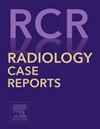Hybrid imaging of a pseudoaneurysm of the descending thoracic aorta induced by a dorsal osteophyte: The silent killer
Q4 Medicine
引用次数: 0
Abstract
Vertebral osteophytes are the result of intervertebral disc degeneration and can occasionally damage the aorta located in their proximity. This paper describes the case of a 69-year-old woman with a pseudoaneurysm of the descending thoracic aorta caused by a progressively growing dorsal osteophyte. The patient was asymptomatic as the pseudoaneurysm was an incidental finding diagnosed with an 18F-FDG PET/CT and computed tomography angiography (CTA) performed during follow-up for breast cancer. The comparison between the latest 18F-FDG PET/CTA performed and previous exams was crucial for the diagnosis. In fact, the authors were able to demonstrate the progressive growth of the osteophyte and the subsequent development of the pseudoaneurysm. Both morphological features and metabolic behaviors supported the diagnosis. The pseudoaneurysm was successfully treated with thoracic endograft.
由背侧骨赘引起的胸降主动脉假性动脉瘤的混合成像:沉默的杀手
椎体骨赘是椎间盘退变的结果,偶尔会损害其附近的主动脉。本文描述的情况下,69岁的妇女与假性动脉瘤的胸降主动脉引起的逐渐增长的背骨赘。患者无症状,假性动脉瘤是偶然发现的,在乳腺癌随访期间进行了18F-FDG PET/CT和计算机断层血管造影(CTA)诊断。最新的18F-FDG PET/CTA检查与以往检查的比较对诊断至关重要。事实上,作者能够证明骨赘的进行性生长和假性动脉瘤的后续发展。形态学特征和代谢行为均支持诊断。假性动脉瘤经胸腔内移植术治疗成功。
本文章由计算机程序翻译,如有差异,请以英文原文为准。
求助全文
约1分钟内获得全文
求助全文
来源期刊

Radiology Case Reports
Medicine-Radiology, Nuclear Medicine and Imaging
CiteScore
1.10
自引率
0.00%
发文量
1074
审稿时长
30 days
期刊介绍:
The content of this journal is exclusively case reports that feature diagnostic imaging. Categories in which case reports can be placed include the musculoskeletal system, spine, central nervous system, head and neck, cardiovascular, chest, gastrointestinal, genitourinary, multisystem, pediatric, emergency, women''s imaging, oncologic, normal variants, medical devices, foreign bodies, interventional radiology, nuclear medicine, molecular imaging, ultrasonography, imaging artifacts, forensic, anthropological, and medical-legal. Articles must be well-documented and include a review of the appropriate literature.
 求助内容:
求助内容: 应助结果提醒方式:
应助结果提醒方式:


